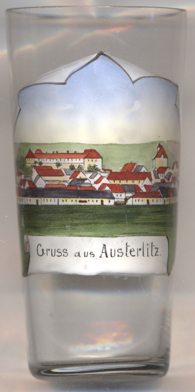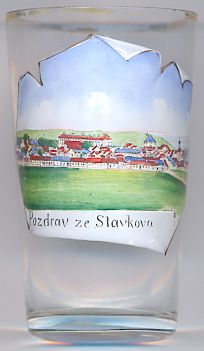

|
| ČESKÁ REPUBLIKA | CZECH REPUBLIC |
| Jihomoravský kraj | South Moravia (Brno) region |
| Okres: Vyškov |

 Slavkov u Brna (in German: Austerlitz) is situated at an elevation of 211 m east of Brno in the
Vyškov district of South Moravia. The town has a population of about 6,000 (2005).
The town is widely known for giving its name to the Battle of Austerlitz which actually took place some kilometers to the west of the town.
Slavkov u Brna (in German: Austerlitz) is situated at an elevation of 211 m east of Brno in the
Vyškov district of South Moravia. The town has a population of about 6,000 (2005).
The town is widely known for giving its name to the Battle of Austerlitz which actually took place some kilometers to the west of the town.
At the beginning of the 13th century, the Teutonic Order built a monastery stronghold whose remains can still be seen today in the vaults of Austerlitz Palace. The first written testimony about the place date from 1237, the Czech name Slavkov is first documented in 1361. The German name Austerlitz is first documented in 1633 and is said to be a truncation of the Czech Novosedlice, which means "new settlement", although this cannot be clarified definitively. After the dissolution of the Order, the town became the property of a number of noble owners. At the beginning of the 15th century the domains were in possession of the lords of Sternberg (Šternberk). In 1416 Slavkov became the first town in the Czech Lands to be granted (by King Václáv (Wenceslaus) IV) the privilege of having its own emblem. In 1509, the local gentry family of Kaunitz (Czech: z Kounic) assumed control for more than 400 years.
The  parish church of the Lord's Resurrection (farní kostel Vzkříšení Páně)
[left, no. 3858, and right, no. 2295: background right]
was rebuilt in Classicist style in 1786–1789 by the architect Johann Ferdinand Hetzendorf von Hohenberg. The massive neo-Classical façade
is inspired by that of St. Mary Magdalene in Paris.
parish church of the Lord's Resurrection (farní kostel Vzkříšení Páně)
[left, no. 3858, and right, no. 2295: background right]
was rebuilt in Classicist style in 1786–1789 by the architect Johann Ferdinand Hetzendorf von Hohenberg. The massive neo-Classical façade
is inspired by that of St. Mary Magdalene in Paris.
The Battle of Austerlitz, also known as the Battle of the Three Emperors, was one of Napoleon's greatest victories, effectively destroying the Third Coalition against the French Empire. On 2 December, 1805, French troops, commanded by Emperor Napoleon I, decisively defeated a Russo-Austrian army, commanded by Czar Alexander I, after nearly nine hours of difficult fighting in many sectors. The battle is often regarded as a tactical masterpiece. Austerlitz effectively brought the Third Coalition to an end. On 26 December, 1805, Austria and France signed the Treaty of Pressburg (Bratislava), which took the former out of the war, reinforced the earlier treaties of Campo Formio and Lunéville, made Austria cede land to Napoleon's German allies, and imposed an indemnity of 40 million francs on the defeated Habsburgs. Russian troops were allowed to head back to home soil. Victory at Austerlitz also permitted the creation of the Confederation of the Rhine, a collection of German states intended as a buffer zone between France and the rest of Europe. In 1806, the Holy Roman Empire ceased to exist when Emperor Franz II (Franz I as Emperor of Austria) declared the Holy Roman Empire defunct.

 Austerlitz palace [left, no. 4723, and above, nos. 3858 and 2295: background left] was built on the site of the former monastery stronghold that the Teutonic Order
had founded here in the early 13th century. At the end of the 16th century, a four-winged Renaissance castle was built on the old foundations. In the 1680's,
the castle was rebuilt in Baroque style in order to serve as representative residence of the Kaunitz. The architect was the famous Domenico Martinelli. Beside the
recreation of the palace on a U-shaped ground plan, Martinelli also remodeled the greater part of the town.
In the 1730's, the building works on the palace were continued by Ignacio Valmaggini who altered Martinelli's design by adding extensions to the side wings of the palace.
The palace was completed under Wenzel Anton count Kaunitz-Rietberg (prince of the empire from 1763), certainly the most famous member of the Kaunitz family. He served as Austrian Staatskanzler
(Chancellor of State, i.e. foreign minister) from 1753 until 1792. The palace has 115 rooms and an impressive garden in the French style.
In its historic salon, an armistice was signed between Austria and France after the battle of Austerlitz on 2 December, 1805.
Austerlitz palace [left, no. 4723, and above, nos. 3858 and 2295: background left] was built on the site of the former monastery stronghold that the Teutonic Order
had founded here in the early 13th century. At the end of the 16th century, a four-winged Renaissance castle was built on the old foundations. In the 1680's,
the castle was rebuilt in Baroque style in order to serve as representative residence of the Kaunitz. The architect was the famous Domenico Martinelli. Beside the
recreation of the palace on a U-shaped ground plan, Martinelli also remodeled the greater part of the town.
In the 1730's, the building works on the palace were continued by Ignacio Valmaggini who altered Martinelli's design by adding extensions to the side wings of the palace.
The palace was completed under Wenzel Anton count Kaunitz-Rietberg (prince of the empire from 1763), certainly the most famous member of the Kaunitz family. He served as Austrian Staatskanzler
(Chancellor of State, i.e. foreign minister) from 1753 until 1792. The palace has 115 rooms and an impressive garden in the French style.
In its historic salon, an armistice was signed between Austria and France after the battle of Austerlitz on 2 December, 1805.
Glass no. 4723 is labeled in Czech: Upominka z Napoleonské výstavy ve Slavkově 1931
('Souvenir from the Napoleonic Exhibition in Austerlitz 1931'). The exhibition was held in Slavkov castle from
28 June to 19 July 1931 to commemorate the 125th anniversary of the Battle of Slavkov and the 120th
anniversary of the death of Emperor Napoléon I. Originally, the exhibition was intended as a manifestation
in favor of global peace, but the national defense ministry objected to “inappropriate pacifism” and demanded of the
exhibition organizers that the main purpose of the exhibition be the emphasis of Czechoslovak-French amity. The exhibition
was a success in every way, and a total of 73,000 Czechoslovak and foreign persons visited it. After it closed it was
moved to Prague, where it was organized by the Prague Sample Trade Fairs, and it also enjoyed
great success there.
[http://en.wikipedia.org/wiki/Salvkov_u_Brna, http://www.vitejte.cz/objekt.php?oid=726&j=en;
http://en.wikipedia.org/wiki/Battle_of_Austerlitz;
https://www.austerlitz.org/en/napoleon-days-2003-austerlitz/]
![[scale]](lineal.jpg)